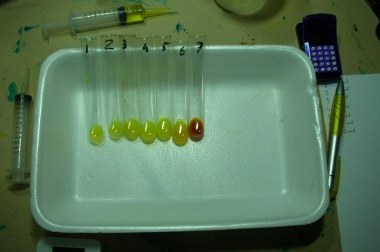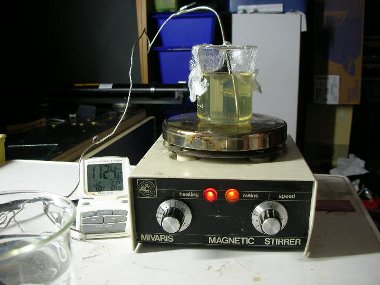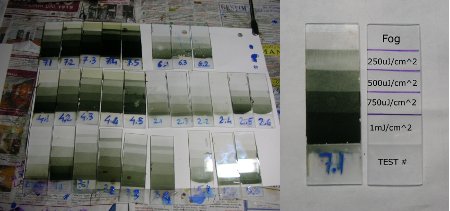
Plates are coated and dried under Laminar Floor Hoods in order to reduce the risk of dirt contamination. Finished materials are then packaged and stored in cold environment between +1 ..+5 Celsius. Plates are hence tested using a 20mW JDS He-Ne red Laser and a 100mW Coherent C-315 green Laser. More experiments are in progress with a homemade Ruby Laser.
Silver halide grain size
As for conventional photography, holographic emulsions are a
dispersion of Silver bromide in a inert support. The main difference between the
two is the grain size, while in standard photography silver grain size is often
greater than 500nm, in holography the silver grains must be less than 20-30nm.
Good and efficient Holographic Materials usually have grains dimensions less
than 15nm.
chemicals purity importance
Emulsions are
prepared starting from highly purified gelatin and high grade chemicals. Stock
solutions are freshly prepared; aged, foggy and/or uncertain solutions are
always discarted.
In the past I used to buy cheaper
low grade chemicals and I often reused old tanned stock
solutions, now I know that spending a bit more money is better than
waste hours and hours of preciuous time, and obviously throw away bulks of
chemicals.
During silver bromide precipitation low grade chemicals might
cause side effects as sensitivity alteration, fog formation, shortened
shelf life.
Water is another important factor to control. Water used
during emulsification should be highly purified as pharmaceutical bi-distilled
water is, while water used for emulsion rinses can be reverse-osmosis water
.
Chemicals purity for reagents used in developers and bleaches can
be lower than those used during fabrication of emulsion.
emulsions characterization
Experimental Handmade Holographic
Emulsions are coated on microscope slides characterized evauating the following
parameters:
- Sensitivity
(Optical Density=0.5)
-
Fog level after forced ageing
-
Diffraction Efficiency
Sensitivity is accurately measured exposing the
microscope slide to a calibrated laser light source at different exposure
times, test slides are then developed and their Optical
Density and Fog Level are measured.
Ageing is firstly simulated by heating the test
slides at controlled temperature and humidity using an empiric formula, if
satisfactory expected Shelf Life improvements are got, than a batch
of plates is coated and stored for real ageing tests.
Diffraction Efficiency is
finally
evaluated making a Single Beam Hologram developed in fresh developer at known
environmental conditions.
notes on optical sensitivity
Despite of conventional photography, in Holography it is very hard to say how sensitive a material is. In the past Agfa declared for the now discontinued Holotest 8E75-HD-NAH a sensitivity of 75uJ/cm^2 to get an Optical Density of 0.5.
Who makes holograms knows that exposure calculations and instrumental measurements are useful only to have a rough idea of the actual exposure time. Many factors should have to be considered for calculating the right exposure time, the fast way is to make a rought measurement and a few tests at differents exposure times.
By the way Single Beam Reflection Holograms (Denisyuk) need more energy density than a Dual Beam Transmission Hologram
Another important aspect is that overexposing a Denisyuk Hologram causes the formation of colloidal silver increasing the efficiency of the final holographic image.

High purity gelatin before emulsification


On the left a Homemade Laminar Flow Hood used to dry in clean environment the plates, on the right a stack of 30 plates ready for use, note how the safe light passes through the whole pack without any scattering, this is possible thanks to the ultrafine grain of the emulsion.

On the left test emulsions coated on microscope slides, on the right a test slide exposed and developed

Diffraction Efficiency is evaluated exposing a Denisyuk Hologram